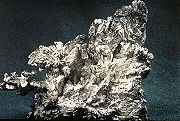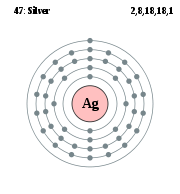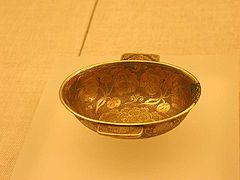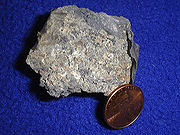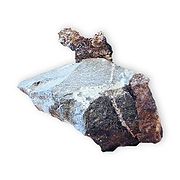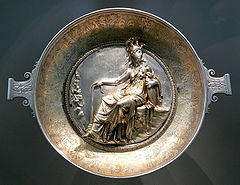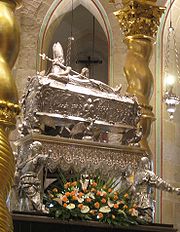Silver
From Wikipedia, the free encyclopedia
| ||||||||||||||||||||||||||||||||||||||||||||||||||||||||||
| General | ||||||||||||||||||||||||||||||||||||||||||||||||||||||||||
|---|---|---|---|---|---|---|---|---|---|---|---|---|---|---|---|---|---|---|---|---|---|---|---|---|---|---|---|---|---|---|---|---|---|---|---|---|---|---|---|---|---|---|---|---|---|---|---|---|---|---|---|---|---|---|---|---|---|---|
| Name, Symbol, Number | silver, Ag, 47 | |||||||||||||||||||||||||||||||||||||||||||||||||||||||||
| Element category | transition metals | |||||||||||||||||||||||||||||||||||||||||||||||||||||||||
| Group, Period, Block | 11, 5, d | |||||||||||||||||||||||||||||||||||||||||||||||||||||||||
| Appearance | lustrous white metal | |||||||||||||||||||||||||||||||||||||||||||||||||||||||||
| Standard atomic weight | 107.8682(2) g·mol−1 | |||||||||||||||||||||||||||||||||||||||||||||||||||||||||
| Electron configuration | [Kr] 4d10 5s1 | |||||||||||||||||||||||||||||||||||||||||||||||||||||||||
| Electrons per shell | 2, 8, 18, 18, 1 | |||||||||||||||||||||||||||||||||||||||||||||||||||||||||
| Physical properties | ||||||||||||||||||||||||||||||||||||||||||||||||||||||||||
| Color | silver | |||||||||||||||||||||||||||||||||||||||||||||||||||||||||
| Phase | solid | |||||||||||||||||||||||||||||||||||||||||||||||||||||||||
| Density (near r.t.) | 10.49 g·cm−3 | |||||||||||||||||||||||||||||||||||||||||||||||||||||||||
| Liquid density at m.p. | 9.320 g·cm−3 | |||||||||||||||||||||||||||||||||||||||||||||||||||||||||
| Melting point | 1234.93 K (961.78 °C, 1763.2 °F) | |||||||||||||||||||||||||||||||||||||||||||||||||||||||||
| Boiling point | 2435 K (2162 °C, 3924 °F) | |||||||||||||||||||||||||||||||||||||||||||||||||||||||||
| Heat of fusion | 11.28 kJ·mol−1 | |||||||||||||||||||||||||||||||||||||||||||||||||||||||||
| Heat of vaporization | 250.58 kJ·mol−1 | |||||||||||||||||||||||||||||||||||||||||||||||||||||||||
| Specific heat capacity | (25 °C) 25.350 J·mol−1·K−1 | |||||||||||||||||||||||||||||||||||||||||||||||||||||||||
| ||||||||||||||||||||||||||||||||||||||||||||||||||||||||||
| Atomic properties | ||||||||||||||||||||||||||||||||||||||||||||||||||||||||||
| Crystal structure | face-centered cubic | |||||||||||||||||||||||||||||||||||||||||||||||||||||||||
| Oxidation states | 1, 2, 3 (amphoteric oxide) | |||||||||||||||||||||||||||||||||||||||||||||||||||||||||
| Electronegativity | 1.93 (Pauling scale) | |||||||||||||||||||||||||||||||||||||||||||||||||||||||||
| Ionization energies | 1st: 731.0 kJ/mol | |||||||||||||||||||||||||||||||||||||||||||||||||||||||||
| 2nd: 2070 kJ/mol | ||||||||||||||||||||||||||||||||||||||||||||||||||||||||||
| 3rd: 3361 kJ/mol | ||||||||||||||||||||||||||||||||||||||||||||||||||||||||||
| Atomic radius | 160 pm | |||||||||||||||||||||||||||||||||||||||||||||||||||||||||
| Atomic radius (calc.) | 165 pm | |||||||||||||||||||||||||||||||||||||||||||||||||||||||||
| Covalent radius | 153 pm | |||||||||||||||||||||||||||||||||||||||||||||||||||||||||
| Van der Waals radius | 172 pm | |||||||||||||||||||||||||||||||||||||||||||||||||||||||||
| Miscellaneous | ||||||||||||||||||||||||||||||||||||||||||||||||||||||||||
| Magnetic ordering | diamagnetic | |||||||||||||||||||||||||||||||||||||||||||||||||||||||||
| Electrical resistivity | (20 °C) 15.87 n Ω·m | |||||||||||||||||||||||||||||||||||||||||||||||||||||||||
| Thermal conductivity | (300 K) 429 W·m−1·K−1 | |||||||||||||||||||||||||||||||||||||||||||||||||||||||||
| Thermal diffusivity | (300 K) 174 mm²/s | |||||||||||||||||||||||||||||||||||||||||||||||||||||||||
| Thermal expansion | (25 °C) 18.9 µm·m−1·K−1 | |||||||||||||||||||||||||||||||||||||||||||||||||||||||||
| Speed of sound (thin rod) | (r.t.) 2680 m·s−1 | |||||||||||||||||||||||||||||||||||||||||||||||||||||||||
| Young's modulus | 83 GPa | |||||||||||||||||||||||||||||||||||||||||||||||||||||||||
| Shear modulus | 30 GPa | |||||||||||||||||||||||||||||||||||||||||||||||||||||||||
| Bulk modulus | 100 GPa | |||||||||||||||||||||||||||||||||||||||||||||||||||||||||
| Poisson ratio | 0.37 | |||||||||||||||||||||||||||||||||||||||||||||||||||||||||
| Mohs hardness | 2.5 | |||||||||||||||||||||||||||||||||||||||||||||||||||||||||
| Vickers hardness | 251 MPa | |||||||||||||||||||||||||||||||||||||||||||||||||||||||||
| Brinell hardness | 24.5 MPa | |||||||||||||||||||||||||||||||||||||||||||||||||||||||||
| CAS registry number | 7440-22-4 | |||||||||||||||||||||||||||||||||||||||||||||||||||||||||
| Most-stable isotopes | ||||||||||||||||||||||||||||||||||||||||||||||||||||||||||
| ||||||||||||||||||||||||||||||||||||||||||||||||||||||||||
| References | ||||||||||||||||||||||||||||||||||||||||||||||||||||||||||
Silver (pronounced /ˈsɪlvɚ/) is a chemical element with the chemical symbol Ag (Latin: argentum, from the Ancient Greek: ἀργήεντος - argēentos, gen. of ἀργήεις - argēeis, "white, shining" ) and atomic number 47. A soft, white, lustrous transition metal, it has the highest electrical conductivity of any element and the highest thermal conductivity of any metal. The metal naturally occurs in its pure, free form (native silver) and as an alloy with gold (electrum), as well as in various minerals, such as argentite and chlorargyrite. Most silver is produced as a by-product of copper, gold, lead, and zinc refining.
Silver has been known since ancient times and has long been valued as a precious metal, used to make ornaments, jewelry, high-value tableware and utensils (hence the term silverware) and currency coins. Today, silver metal is used in electrical contacts and conductors, in mirrors and in catalysis of chemical reactions. Its compounds are used in photographic film and dilute solutions of silver nitrate and other silver compounds are used as disinfectants. Although the antimicrobial uses of silver have largely been supplanted by the use of antibiotics, further research into its clinical potential is in progress.
Contents |
[edit] Occurrence and extraction
Silver is found in native form, alloyed with gold or combined with sulfur, arsenic, antimony or chlorine in ores such as argentite (Ag2S), horn silver (AgCl), and pyrargyrite (Ag3SbS3). The principal sources of silver are the ores of copper, copper-nickel, lead, and lead-zinc obtained from Peru, Mexico, China, Australia, Chile, Poland and Kosovo. Peru and Mexico have been mining silver since 1546 and are still major world producers. Top silver-producing mines are Proaño / Fresnillo (Mexico), Cannington (Queensland, Australia), Dukat (Russia), Uchucchacua (Peru) and Greens Creek mine (Alaska).[1]
The metal can also be produced during the electrolytic refining of copper and by the application of the Parkes process on lead metal obtained from lead ores that contain small amounts of silver. Commercial-grade fine silver is at least 99.9% pure silver, and purities greater than 99.999% are available. In 2007, Peru was the world's top producer of silver, closely followed by Mexico, according to the British Geological Survey.
[edit] Characteristics
Silver is a very ductile and malleable (slightly harder than gold) monovalent coinage metal with a brilliant white metallic luster that can take a high degree of polish. It has the highest electrical conductivity of all metals, even higher than copper, but its greater cost and tarnishability have prevented it from being widely used in place of copper for electrical purposes, though 13540 tons were used in the electromagnets used for enriching uranium during World War II (mainly because of the wartime shortage of copper). Another notable exception is in high-end audio cables.[2]
Among metals, pure silver has the highest thermal conductivity[3] (the non-metal diamond and superfluid helium II are higher), the whitest color, and the highest optical reflectivity[4] (although aluminium slightly outdoes it in parts of the visible spectrum, and it is a poor reflector of ultraviolet light). Silver also has the lowest contact resistance of any metal. Silver halides are photosensitive and are remarkable for their ability to record a latent image that can later be developed chemically. Silver is stable in pure air and water, but tarnishes when it is exposed to air or water containing ozone or hydrogen sulfide. The most common oxidation state of silver is +1 (for example, silver nitrate: AgNO3); in addition, +2 compounds (for example, silver(II) fluoride: AgF2) and +3 compounds (for example, potassium tetrafluoroargentate: K[AgF4]) are known.
[edit] Isotopes
Naturally occurring silver is composed of two stable isotopes, 107Ag and 109Ag, with 107Ag being the most abundant (51.839% natural abundance). Silver's standard atomic mass is 107.8682(2) u. Twenty-eight radioisotopes have been characterized, the most stable being 105Ag with a half-life of 41.29 days, 111Ag with a half-life of 7.45 days, and 112Ag with a half-life of 3.13 hours.
All of the remaining radioactive isotopes have half-lives that are less than an hour, and the majority of these have half-lives that are less than 3 minutes. This element has numerous meta states, the most stable being 108mAg (t* 418 years), 110mAg (t* 249.79 days) and 106mAg (t* 8.28 days).
Isotopes of silver range in atomic weight from 93.943 u (94Ag) to 123.929 u (124Ag), the primary decay mode before the most abundant stable isotope, 107Ag, is electron capture and the primary mode after is beta decay. The primary decay products before 107Ag are palladium (element 46) isotopes, and the primary products after are cadmium (element 48) isotopes.
The palladium isotope 107Pd decays by beta emission to 107Ag with a half-life of 6.5 million years. Iron meteorites are the only objects with a high-enough palladium-to-silver ratio to yield measurable variations in 107Ag abundance. Radiogenic 107Ag was first discovered in the Santa Clara meteorite in 1978. The discoverers suggest that the coalescence and differentiation of iron-cored small planets may have occurred 10 million years after a nucleosynthetic event. 107Pd–107Ag correlations observed in bodies that have clearly been melted since the accretion of the solar system must reflect the presence of unstable nuclides in the early solar system.[citation needed]
[edit] Silver compounds
Silver metal dissolves readily in nitric acid (HNO3) to produce silver nitrate (AgNO3), a transparent crystalline solid that is photosensitive and readily soluble in water. Silver nitrate is used as the starting point for the synthesis of many other silver compounds, as an antiseptic, and as a yellow stain for glass in stained glass. Silver metal does not react with sulfuric acid, which is used in jewellery-making to clean and remove copper oxide firescale from silver articles after silver soldering or annealing. However, silver reacts readily with sulfur or hydrogen sulfide H2S to produce silver sulfide, a dark-coloured compound familiar as the tarnish on silver coins and other objects. Silver sulfide also forms silver whiskers when silver electrical contacts are used in an atmosphere rich in hydrogen sulfide.
Silver chloride (AgCl) is precipitated from solutions of silver nitrate in the presence of chloride ions, and the other silver halides used in the manufacture of photographic emulsions are made in the same way using bromide or iodide salts. Silver chloride is used in glass electrodes for pH testing and potentiometric measurement, and as a transparent cement for glass. Silver iodide has been used in attempts to seed clouds to produce rain.
Silver oxide (Ag2O) produced when silver nitrate solutions are treated with a base, is used as a positive electrode (cathode) in watch (battery) batteries. Silver carbonate (Ag2CO3) is precipitated when silver nitrate is treated with sodium carbonate (Na2CO3).
Silver fulminate (AgONC), a powerful, touch-sensitive explosive used in percussion caps, is made by reaction of silver metal with nitric acid in the presence of ethanol (C2H5OH). Another dangerously explosive silver compound is silver azide (AgN3), formed by reaction of silver nitrate with sodium azide (NaN3).
Latent images formed in silver halide crystals are developed by treatment with alkaline solutions of reducing agents such as hydroquinone, metol (4-(methylamino)phenol sulfate) or ascorbate which reduce the exposed halide to silver metal. Alkaline solutions of silver nitrate can be reduced to silver metal by reducing sugars such as glucose, and this reaction is used to silver glass mirrors and the interior of glass Christmas ornaments. Silver halides are soluble in solutions of sodium thiosulfate (Na2S2O3) which is used as a photographic fixer, to remove excess silver halide from photographic emulsions after image development.
Silver metal is attacked by strong oxidizers such as potassium permanganate (KMnO4) and potassium dichromate (K2Cr2O7), and in the presence of potassium bromide (KBr), these compounds are used in photography to bleach silver images, converting them to silver halides that can either be fixed with thiosulfate or re-developed to intensify the original image. Silver forms cyanide complexes (silver cyanide) that are soluble in water in the presence of an excess of cyanide ions. Silver cyanide solutions are used in electroplating of silver.
[edit] Applications
| This article is missing citations or needs footnotes. Please help add inline citations to guard against copyright violations and factual inaccuracies. (July 2008) |
[edit] Precious metal
A major use of silver is as a precious metal, and it has long been used for making high-value objects reflecting the wealth and status of the owner.
Jewellery and silverware are traditionally made from sterling silver (standard silver), an alloy of 92.5% silver with 7.5% copper. In the United States, only an alloy consisting of at least 92.5% fine silver can be marketed as "silver". Sterling silver is harder than pure silver, and has a lower melting point (893 °C) than either pure silver or pure copper. Britannia silver is an alternative hallmark-quality standard containing 95.8% silver, often used to make silver tableware and wrought plate. With the addition of germanium, the patented modified alloy Argentium Sterling Silver is formed, with improved properties including resistance to firescale.
Sterling silver jewelry is often plated with a thin coat of .999 fine silver to give the item a shiny finish. This process is called "flashing". Silver jewelry can also be plated with rhodium (for a bright, shiny look) or gold.
Silver is used in medals, denoting second place. Some high-end musical instruments are made from sterling silver, such as the flute.
[edit] Dentistry
Silver can be alloyed with mercury and tin at room temperature to make amalgams that are widely used for dental fillings. To make dental amalgam, a mixture of powdered silver and other metals is mixed with mercury to make a stiff paste that can be adapted to the shape of a cavity. The dental amalgam achieves initial hardness within minutes but sets hard in a few hours.
[edit] Photography and electronics
Photography used 24% of the silver consumed in 2001 in the form of silver nitrate and silver halides, while 33% was used in jewelry, 40% for industrial uses, and only 3% for coins and medals. [5] However the use of silver in photography does not appear to be declining, despite the switch to digital technology, since in 2007 of the 455.5 million ounces of silver used for industrial applications, over 128 million ounces (28%) were consumed by the photographic sector.[6]
Some electrical and electronic products use silver for its superior conductivity, even when tarnished. For example, printed circuits are made using silver paints,[7] and computer keyboards use silver electrical contacts. Some high-end audio hardware (DACs, preamplifiers, etc.) are fully silver-wired, which is believed to cause the least loss of quality in the signal. Silver cadmium oxide is used in high voltage contacts because it can withstand arcing.
During World War II the short supply of copper brought about the government's use of silver from the Treasury vaults for conductors at Oak Ridge. (After the war ended the silver was returned to the vaults.) [8]
[edit] Solder and brazing
Silver is also used to make solder and brazing alloys, electrical contacts, and high-capacity silver-zinc and silver-cadmium batteries. Silver in a thin layer on top of a bearing material can provide a significant increase in galling resistance and reduce wear under heavy load, particularly against steel.
[edit] Mirrors and optics
Mirrors which need superior reflectivity for visible light are made with silver as the reflecting material in a process called silvering, though common mirrors are backed with aluminium. Using a process called sputtering, silver (and sometimes gold) can be applied to glass at various thicknesses, allowing different amounts of light to penetrate. Silver is usually reserved for coatings of specialized optics, and the silvering most often seen in architectural glass and tinted windows on vehicles is produced by sputtered aluminium, which is cheaper and less susceptible to tarnishing and corrosion.
[edit] Nuclear reactors
Because silver readily absorbs free neutrons, it is commonly used to make control rods that regulate the fission chain reaction in pressurized water nuclear reactors, generally in the form of an alloy containing 80% silver, 15% indium, and 5% cadmium.
[edit] Catalyst
Silver's catalytic properties make it ideal for use as a catalyst in oxidation reactions, for example, the production of formaldehyde from methanol and air by means of silver screens or crystallites containing a minimum 99.95 weight-percent silver. Silver (upon some suitable support) is probably the only catalyst available today to convert ethylene to ethylene oxide (later hydrolyzed to ethylene glycol, used for making polyesters)—a very important industrial reaction.
Oxygen dissolves in silver relatively easily compared to other gases present in air. Attempts have been made to construct silver membranes of only a few monolayers thickness. Such a membrane could be used to filter pure oxygen from air and water.
[edit] Currency
Silver, in the form of electrum (a gold-silver alloy), was coined to produce money in around 700 BCE by the Lydians. Later, silver was refined and coined in its pure form. Many nations used silver as the basic unit of monetary value. The words for "silver" and "money" are the same in at least 14 languages. In the modern world, silver bullion has the ISO currency code XAG. The name of the United Kingdom monetary unit "pound" reflects the fact that it originally represented the value of one troy pound of sterling silver. In the 1800s, many nations, such as the United States and Great Britain, switched from silver to a gold standard of monetary value, then in the 20th century to fiat currency.
[edit] Medicine
Silver ions and silver compounds show a toxic effect on some bacteria, viruses, algae and fungi, typical for heavy metals like lead or mercury, but without the high toxicity to humans that are normally associated with these other metals. Its germicidal effects kill many microbial organisms in vitro, but testing and standardization of silver products is difficult.[9]
Hippocrates, the father of modern medicine, wrote that silver had beneficial healing and anti-disease properties[cite this quote], and the Phoenicians used to store water, wine, and vinegar in silver bottles to prevent spoiling. In the early 1900s people would put silver dollars in milk bottles to prolong the milk's freshness. [10] Its germicidal effects increase its value in utensils and as jewellery. The exact process of silver's germicidal effect is still not well understood, although theories exist. One of these is the oligodynamic effect, which explains the effect on microorganisms but would not explain antiviral effects.
Silver compounds were used to prevent infection in World War I before the advent of antibiotics. Silver nitrate solution was a standard of care but was largely replaced by silver sulfadiazine cream (SSD Cream),[11] which was generally the "standard of care" for the antibacterial and antibiotic treatment of serious burns until the late 1990s.[12] Now, other options, such as silver-coated dressings (activated silver dressings), are used in addition to SSD cream. However, the evidence for the use of such silver-treated dressings is mixed and although the evidence on if they are effective is promising; it is marred by the poor quality of the trials used to assess these products.[13] Consequently a major systematic review by the Cochrane Collaboration found insufficient evidence to recommend the use of silver-treated dressings to treat infected wounds.[14]
The widespread use of silver went out of fashion with the development of modern antibiotics. However, recently there has been renewed interest in silver as a broad-spectrum antimicrobial. In particular, silver is being used with alginate, a naturally occurring biopolymer derived from seaweed, in a range of products designed to prevent infections as part of wound management procedures, particularly applicable to burn victims.[15] In 2007, AGC Flat Glass Europe introduced the first antibacterial glass to fight hospital-caught infection: it is covered with a thin layer of silver.[16] In addition, Samsung has introduced washing machines with a final rinse containing silver ions to provide several days of antibacterial protection in the clothes.[17] Kohler has introduced a line of toilet seats that have silver ions embedded to kill germs. A company called Thomson Research Associates has begun treating products with Ultra Fresh, an anti-microbial technology involving "proprietary nano-technology to produce the ultra-fine silver particles essential to ease of application and long-term protection."[18] The U.S. Food and Drug Administration (FDA) has recently approved an endotracheal breathing tube with a fine coat of silver for use in mechanical ventilation, after studies found it reduced the risk of ventilator-associated pneumonia.[19]
It has long been known that antibacterial action of silver is enhanced by the presence of an electric field. Applying a few volts of electricity across silver electrodes drastically enhances the rate that bacteria in solution are killed. It was found recently that the antibacterial action of silver electrodes is greatly improved if the electrodes are covered with silver nanorods.[20]
[edit] Medication
Today, various kinds of silver compounds, or devices to make solutions or colloids containing silver, are sold as remedies for a wide variety of diseases. Although most colloidal silver preparations are harmless, some people using these home-made solutions excessively have developed argyria over a period of months or years.[21] High doses of colloidal silver can result in coma, pleural edema, and hemolysis.[22]
Silver is widely used in topical gels and impregnated into bandages because of its wide-spectrum antimicrobial activity. The anti-microbial properties of silver stem from the chemical properties of its ionized form, Ag+. This ion forms strong molecular bonds with other substances used by bacteria to respire, such as molecules containing sulfur, nitrogen, and oxygen.[23] Once the Ag+ ion complexes with these molecules, they are rendered unusable by the bacteria, depriving it of necessary compounds and eventually leading to the bacteria's death.
[edit] Food
In India and Pakistan, foods, especially sweets, can be found decorated with a thin layer of silver known as vark. Silver as a food additive is given the E number E174 and is classed as a food coloring. It is used solely for external decoration, such as on chocolate confectionery, in the covering of dragées and the decoration of sugar-coated flour confectionery. In Australia, it is banned as a food additive.
[edit] Clothing
Silver inhibits the growth of bacteria and fungi. It keeps odour to a minimum and reduces the risk of bacterial and fungal infection. In clothing, the combination of silver and moisture movement (wicking) may help to reduce the harmful effects of prolonged use in active and humid conditions.
Silver is used in clothing in two main forms:
- A form in which silver ions are integrated into the polymer from which yarns are made (a form of nanotechnology)
- A form in which the silver is coated onto the yarns.
In both cases the silver prevents the growth of a broad spectrum of bacteria and fungi.
Recorded use of silver to prevent infection dates to ancient Greece and Rome, it was rediscovered in the Middle Ages, where it was used for several purposes, such as to disinfect water and food during storage, and also for the treatment of burns and wounds as wound dressing. In the 19th century, sailors on long ocean voyages would put silver coins in barrels of water and wine to keep the liquid pure. Pioneers in America used the same idea as they made their journey from coast to coast. Silver solutions were approved in the 1920s by the US Food and Drug Administration for use as antibacterial agents. Today, wound dressings containing silver are well established for clinical wound care and have recently been introduced in consumer products such as sticking plasters.[24]
[edit] Silversmithery
During the Renaissance and Baroque periods in the sixteenth and seventeenth centuries, Paris was one of the great centers for the creation of lavish silver and gold objects. However, many of them were melted down to pay the heavy cost of Louis XIV's wars. Ewers and basins - originally functional objects for washing hands-were used at this time to decorate elaborate buffets on ceremonial occasions, which explains their large proportions and lavish ornamentation.
Ewers and basins were used for both practical and ceremonial purposes. Often, as is the case here, the ewer and basin were created by different silversmiths but formed a set. The designs of silver changed dramatically from the 17th century. In 1625 Henrietta Maria, the daughter of Henri IV and Marie de Medicis of France was married to Charles I of England. There is no complete description of the silver and gold objects for the wedding, and this ewer and basin are not recorded in the personal inventory of the French-born queen. However, they were most likely commissioned by the French crown to decorate the splendid buffet at the wedding banquet and then given to the couple. Both objects are listed in the English royal treasury in 1664 as the property of the crown, having escaped the fate of much of the treasury that was sold at the time of the English Civil War.
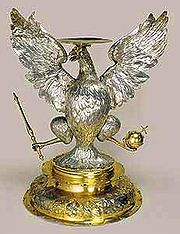
Besides Paris, Nuremberg was one of the primary cities for goldsmiths' work from the beginning of the sixteenth century until about 1648. Because of its strict guild rules and excellent artisans, Nuremberg was the main center of silversmithing in Germany at the time, attracting an international clientele. The type of covered cup was a regular feature of Nuremberg production during the second half of the seventeenth century and numerous examples by various silversmiths survive. The style rapidly spread throughout Germany and became known elsewhere. In northern Germany, cups like this were presented as gifts on special occasions, including accessions and coronations. They were also often filled with gold coins as a mark of respect to the recipient. One of the most famous silversmiths in Nuremberg during the late sixteenth and early seventeenth century was Hans Petzolt.
Another renowned center for the production of silver and gold objects during the seventeenth century was Augsburg. Like Nuremberg, Augsburg was celebrated because of dynasties of goldsmiths like the Drentwetts and the Billers, who were patronized by European rulers such as Leopold I, emperor of the Holy Roman Empire and John II Casimir of Poland.[25] From about 1640 also Amsterdam was an active center for the production of silver decorated with lush floral motifs.
In Poland the craft of silversmiths followed the general development of Western European traditions and styles. Most of the masters arrived from the major cities of Western Europe such as Nuremberg, Augsburg and Amsterdam. They brought with them new shapes and objects. The main centers of silver manufacture in Poland during the 17th and 18th centuries were the cities of Gdańsk and Wrocław. Chased goblets by Jakob Schmidt I and Lukas Kadau date from the 1620’s to 1640’s. The works by Christian Paulsen and Andrzej Mackenzen date from the middle of the 17th century. Works by different branches of the Rode family of jewelers, who were well known in Gdańsk from the mid-15th century, are also interesting, particularly Peter II Rode and his sons Peter III and Johann II. There are large silver castings by Piotr von der Rennen representing relic coffins in Gniezno and Wawel Cathedral. Spoons made by Polish masters in the 17th and 18th centuries are widely known. The spoons often have moralizing phrases engraved on their handles.
[edit] History

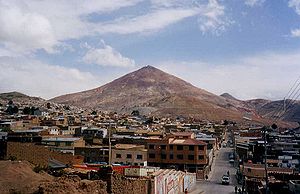
The word "silver" appears in Anglo-Saxon in various spellings such as seolfor and siolfor. A similar form is seen throughout the Teutonic languages (compare Old High German silabar and silbir). The chemical symbol Ag is from the Latin for "silver", argentum (compare Greek άργυρος, árgyros), from the Indo-European root *arg- meaning "white" or "shining".
Silver has been known since ancient times. It is mentioned in the book of Genesis, and slag heaps found in Asia Minor and on the islands of the Aegean Sea indicate that silver was being separated from lead as early as the 4th millennium BC using surface mining.
In the Gospels, Jesus' disciple Judas Iscariot is infamous for having taken a bribe of thirty coins of silver from religious leaders in Jerusalem to turn Jesus Christ over to the Romans.
Set aside certain circumstances[clarification needed], Islam permits Muslim men to wear silver jewelry. Muhammad himself wore a silver signet ring.
[edit] Price
As of October 2008 silver is about 1/75th the price of gold by mass[26]. Silver once traded at 1/6th to 1/12th the price of gold, prior to the Age of Discovery and the discovery of great silver deposits in the Americas, including Peru, Mexico and the United States, such as the vast Comstock Lode in Virginia City, Nevada, USA. This then resulted in the debate over cheap Free Silver to benefit the agricultural sector, which was among the most prolonged and difficult in that country's history[clarification needed] and dominated public discourse during the latter decades of the nineteenth century.
Over the last 100 years the price of silver and the gold/silver price ratio have fluctuated greatly due to competing industrial and store-of-value demands. In 1980 the silver price rose to an all-time high of US$49.45 per troy ounce. By December 2001 the price had dropped to US$4.15 per ounce, and in May 2006 it had risen back as high as US$15.21 per ounce. As of 2006, silver costs (and most other metal prices) have been rather volatile, for example, quickly dropping from the May high of US$15.21 per ounce to a June low of US$9.60 per ounce before rising back above US$12.00 per ounce by August. In March 2008 silver reached US$21.34 per ounce.[27]
The price of silver is important in Judaic Law. The lowest fiscal amount that a Jewish court, or Beth Din, can convene to adjudicate a case over is a shova pruta (value of a Babylonian pruta coin). This is fixed at 1/8 of a gram of pure, unrefined silver, at market price.
[edit] Folklore and popular culture
Silver in European folklore has long been traditionally believed to be an antidote to various maladies and mythical[citation needed] monsters. Notably, silver was believed to be a repellent against vampires (this primarily originates from its holy connotations; also, mirrors were originally polished silver, and as such, vampires allegedly cannot be seen in them because they have no soul) and it was also believed that a werewolf, in his bestial form, could only be killed by a weapon or bullet made of silver. This has given rise to the term "silver bullet", which is used to describe things that very effectively deal with one specific problem.
In heraldry, the tincture argent, in addition to being shown as silver (this has been shown at times with real silver in official representations), can also be shown as white. Occasionally, the word "silver" is used rather than argent; sometimes this is done across-the-board, sometimes to avoid repetition of the word "argent" in blazon.
[edit] Precautions
Silver plays no known natural biological role in humans, and possible health effects of silver are a subject of dispute. Silver itself is not toxic but most silver salts are, and some may be carcinogenic.
Silver and compounds containing silver (like colloidal silver) can be absorbed into the circulatory system and become deposited in various body tissues leading to a condition called argyria which results in a blue-grayish pigmentation of the skin, eyes, and mucous membranes. Although this condition does not otherwise harm a person's health, it is disfiguring and usually permanent. Argyria is rare, and mild forms are sometimes mistaken for cyanosis.
[edit] See also
- Silver as an investment
- Silver coin
- Silver standard
- Silver mining
- Silver compounds
- Silver Nano
- Silverpoint drawing
[edit] References
- ^ Top silver producers
- ^ Oman, H. (1992). "Not invented here? Check your history". Aerospace and Electronic Systems Magazine 7 (1): 51-53. doi:.
- ^ http://www.webelements.com/silver/
- ^ Edwards, H.W. & Petersen, R.P. (1936) Reflectivity of evaporated silver films. Phys. Rev. 50 (9) 871
- ^ Butterman, WC & Hilliard, HE (2005) Silver. Open file report 2004-1251. US Geological Survey mineral commodity profiles, Reston, Virginia.
- ^ http://www.silverinstitute.org/silver_uses.php
- ^ Los Alamos National Laboratory, Silver, accessed 12 February 2007.
- ^ Building Blocks of the Universe by Isaac Asimov
- ^ Chopra I (April 2007). "The increasing use of silver-based products as antimicrobial agents: a useful development or a cause for concern?". The Journal of antimicrobial chemotherapy 59 (4): 587–90. doi:. PMID 17307768.
- ^ "Antibacterial effects of silver". http://www.saltlakemetals.com/Silver_Antibacterial.htm.
- ^ Chang TW, Weinstein L (December 1975). "Prevention of herpes keratoconjunctivitis in rabbits by silver sulfadiazine". Antimicrob. Agents Chemother. 8 (6): 677–8. PMID 1211919. PMC: 429446. http://aac.asm.org/cgi/pmidlookup?view=long&pmid=1211919.
- ^ Atiyeh BS, Costagliola M, Hayek SN, Dibo SA (March 2007). "Effect of silver on burn wound infection control and healing: review of the literature". Burns : journal of the International Society for Burn Injuries 33 (2): 139–48. doi:. PMID 17137719.
- ^ Lo SF, Hayter M, Chang CJ, Hu WY, Lee LL (August 2008). "A systematic review of silver-releasing dressings in the management of infected chronic wounds". Journal of clinical nursing 17 (15): 1973–85. doi:. PMID 18705778.
- ^ Lo SF, Hayter M, Chang CJ, Hu WY, Lee LL (August 2008). "A systematic review of silver-releasing dressings in the management of infected chronic wounds". Journal of clinical nursing 17 (15): 1973–85. doi:. PMID 18705778.
- ^ Hermans MH (December 2006). "Silver-containing dressings and the need for evidence". The American journal of nursing 106 (12): 60–8; quiz 68–9. PMID 17133010.
- ^ "AGC Flat Glass Europe launches world’s first antibacterial glass". 2007-09-04. http://www.agc-flatglass.eu/AGC+Flat+Glass+Europe/English/Homepage/News/Press+room/Press-Detail-Page/page.aspx/979?pressitemid=1031.
- ^ "Samsung laundry featuring SilverCare Technology". Samsung. http://web.archive.org/web/20060531115914/http://www.samsung.com/PressCenter/PressRelease/PressRelease.asp?seq=20060213_0000233684. Retrieved on 2007-08-06.
- ^ ""Ultra-Fresh technology is based on the power of silver to fight bacteria"". Express Textile. http://www.expresstextile.com/20050731/perspectives01.shtml.
- ^ "FDA Clears Silver-Coated Breathing Tube For Marketing". 2007-11-08. http://www.fda.gov/bbs/topics/NEWS/2007/NEW01741.html. Retrieved on 2007-11-11.
- ^ O. Akhavan and E. Ghaderi "Enhancement of antibacterial properties of Ag nanorods by electric field" Sci. Technol. Adv. Mater. 10 (2009) 015003 free download
- ^ Fung MC, Bowen DL (1996). "Silver products for medical indications: risk-benefit assessment". Journal of toxicology. Clinical toxicology 34 (1): 119–26. PMID 8632503.
- ^ Wadhera A, Fung M (2005). "Systemic argyria associated with ingestion of colloidal silver". Dermatology online journal 11 (1): 12. PMID 15748553. http://dermatology.cdlib.org/111/case_reports/argyria/wadhera.html.
- ^ Slawson RM, Van Dyke MI, Lee H, Trevors JT (January 1992). "Germanium and silver resistance, accumulation, and toxicity in microorganisms". Plasmid 27 (1): 72–9. doi:. PMID 1741462.
- ^ Silver in Textiles and Clothing
- ^ (Polish) "Heraldyczny Orzeł". Skarby polskich Wazów. http://swiadectwotestimony.republika.pl/heraldic.html. Retrieved on 2008-08-18.
- ^ O’Connell, Rhona. "Gold:silver ratio will narrow, but base metals outlook ultra-gloomy – UBS". Mineweb.com. http://www.mineweb.com/mineweb/view/mineweb/en/page33?oid=71867&sn=Detail. Retrieved on 2008-11-13.
- ^ "Silver Cash daily plot". Barchart.com. http://charts3.barchart.com/chart.asp?sym=SIY0&data=A&jav=adv&vol=Y&evnt=adv&grid=Y&code=BSTK&org=stk&fix=.
[edit] External links
| Wikimedia Commons has media related to: Silver |
| Look up silver in Wiktionary, the free dictionary. |
- WebElements.com – Silver
- Society of American Silversmiths
- Silver Statistics and Information, USGS publications on the worldwide production of silver
- The Silver Institute A silver industry website
- A collection of silver items Samples of silver
- Transport, Fate and Effects of Silver in the Environment
- Picture in the Element collection from Heinrich Pniok
|
| |||||||||||||||||||||||||||||||||||||||||
|---|---|---|---|---|---|---|---|---|---|---|---|---|---|---|---|---|---|---|---|---|---|---|---|---|---|---|---|---|---|---|---|---|---|---|---|---|---|---|---|---|---|
| H | He | ||||||||||||||||||||||||||||||||||||||||
| Li | Be | B | C | N | O | F | Ne | ||||||||||||||||||||||||||||||||||
| Na | Mg | Al | Si | P | S | Cl | Ar | ||||||||||||||||||||||||||||||||||
| K | Ca | Sc | Ti | V | Cr | Mn | Fe | Co | Ni | Cu | Zn | Ga | Ge | As | Se | Br | Kr | ||||||||||||||||||||||||
| Rb | Sr | Y | Zr | Nb | Mo | Tc | Ru | Rh | Pd | Ag | Cd | In | Sn | Sb | Te | I | Xe | ||||||||||||||||||||||||
| Cs | Ba | La | Ce | Pr | Nd | Pm | Sm | Eu | Gd | Tb | Dy | Ho | Er | Tm | Yb | Lu | Hf | Ta | W | Re | Os | Ir | Pt | Au | Hg | Tl | Pb | Bi | Po | At | Rn | ||||||||||
| Fr | Ra | Ac | Th | Pa | U | Np | Pu | Am | Cm | Bk | Cf | Es | Fm | Md | No | Lr | Rf | Db | Sg | Bh | Hs | Mt | Ds | Rg | Uub | Uut | Uuq | Uup | Uuh | Uus | Uuo | ||||||||||
| |||||||||||||||||||||||||||||||||||||||||
| |||||||||||||||||


